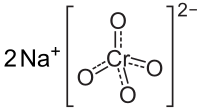Sodium chromate
 |
|
 |
|
| Names | |
|---|---|
|
IUPAC name
Sodium chromate
|
|
| Other names
Chromic acid, (Na2CrO4), disodium salt
Chromium disodium oxide Rachromate |
|
| Identifiers | |
|
7775-11-3 |
|
| 3D model (Jmol) | Interactive image |
| ChEBI |
CHEBI:78671 |
| ECHA InfoCard | 100.028.990 |
| EC Number | 231-889-5 |
| PubChem | 24488 |
| RTECS number | GB2955000 |
| UNII |
6A49BO6K4M |
| UN number | 3288 |
|
|
|
|
| Properties | |
| Na2CrO4 | |
| Molar mass | 161.97 g/mol |
| Appearance | yellow crystals |
| Odor | odorless |
| Density | 2.698 g/cm3 |
| Melting point | 792 °C (1,458 °F; 1,065 K) (anhydrous) 20 °C (decahydrate) |
| 31.8 g/100 mL (0 °C) 84.5 g/100 mL (25 °C) 126.7 g/100 mL (100 °C) |
|
| Solubility | slightly soluble in ethanol |
| Solubility in methanol | 0.344 g/100 mL (25 °C) |
| +55.0·10−6 cm3/mol | |
| Structure | |
| orthorhombic (hexagonal above 413 °C) | |
| Thermochemistry | |
| 142.1 J/mol K | |
|
Std molar
entropy (S |
174.5 J/mol K |
|
Std enthalpy of
formation (ΔfH |
−1329 kJ/mol |
|
Gibbs free energy (ΔfG˚)
|
-1232 kJ/mol |
| Hazards | |
| Safety data sheet | ICSC 1370 |
|
EU classification (DSD)
|
Carc. Cat. 2 Muta. Cat. 2 Repr. Cat. 2 Very toxic (T+) Harmful (Xn) Corrosive (C) Dangerous for the environment (N) |
| R-phrases | R45, R46, R60, R61, R21, R25, R26, R34, R42/43, R48/23, R50/53 |
| S-phrases | S53, S45, S60, S61 |
| NFPA 704 | |
| Flash point | Non-flammable |
| Related compounds | |
|
Other anions
|
Sodium dichromate Sodium molybdate Sodium tungstate |
|
Other cations
|
Potassium chromate Calcium chromate Barium chromate |
|
Except where otherwise noted, data are given for materials in their standard state (at 25 °C [77 °F], 100 kPa).
|
|
|
|
|
| Infobox references | |
Sodium chromate is the inorganic compound with the formula Na2CrO4. It exists as a yellow hygroscopic solid, which can form tetra-, hexa-, and decahydrates. It is an intermediate in the extraction of chromium from its ores. Sodium chromate, like other hexavalent chromium compounds, is toxic and carcinogenic.
It is obtained on a vast scale by roasting chromium ores in air in the presence of sodium carbonate:
This process converts the chromium into a water-extractable form, leaving behind iron oxides. Typically calcium carbonate is included in the mixture to improve oxygen access and to keep silicon and aluminium impurities in an insoluble form. The process temperature is typically around 1100 C. For lab and small scale preparations a mixture of chromite ore, sodium hydroxide and sodium nitrate reacting at lower temperatures may be used (even 350 C in the corresponding potassium chromate system). Subsequent to its formation, the chromate salt is converted to sodium dichromate, the precursor to most chromium compounds and materials. The industrial route to chromium(III) oxide involves reduction of sodium chromate with sulfur.
It converts to sodium dichromate when treated with acids:
Further acidification affords chromium trioxide:
Aside from its central role in the production of chromium from its ores, sodium chromate is used as a corrosion inhibitor in the petroleum industry. It is also a dyeing auxiliary in the textile industry and a wood preservative. It is a diagnostic pharmaceutical in determining red blood cell volume.
In organic chemistry, sodium chromate is used as an oxidant, converting primary alcohols to carboxylic acids and secondary alcohols to ketones.
...
Wikipedia

